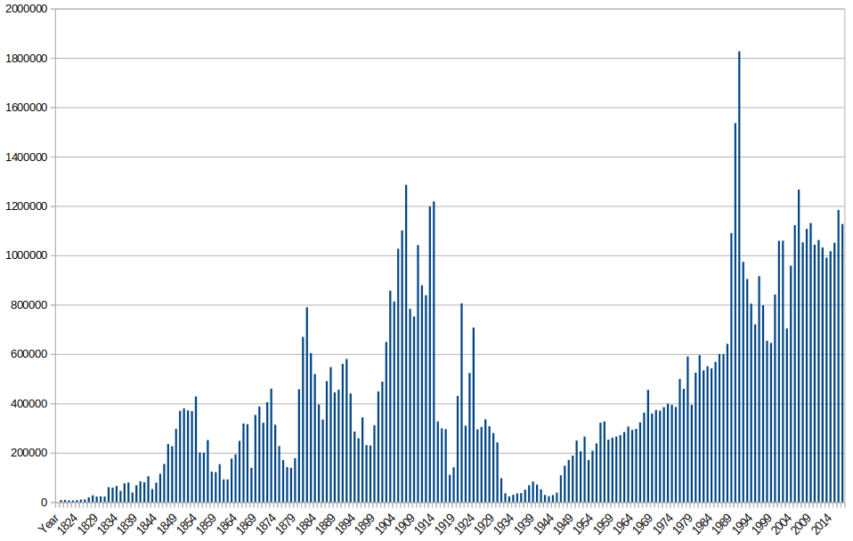Buy: Running the ball with Dalvin Cook early. For the first time since the Lions game, which feels like it was about two seasons ago, Dalvin Cook and the running game got going early in the game. Cook had 32 and 18 yards on consecutive runs in the first half, and the Vikings really looked good running to the perimeter.
Sell: Mostly ignoring Dalvin Cook on the ground. So, that 32 and 18 yard run? the 32 yard run came with 7:41 left in the first quarter, and the 18 yard run, the next time he carried it as a running back, came with 5:39 left … in the second quarter. In the meantime, Minnesota kept dumping off the Cook in the flat for a couple yards here and there (Cook ended up with 8 catches for 23 yards), and one would think after about the 37th dump off pass for three yards, one would try something else. One would be wrong, though.
Buy: The two minute drive to end the first half. Cousins was crisp, throwing dimes down field to Diggs, Rudolph, Robinson, and managed the clock perfectly. He hit Adam Thielen on a perfect out route in the end zone, and there was only :15 seconds left when the Vikings scored; too little time for Tom Brady. Hands down the best two minute drive the Vikings have orchestrated this year.
Sell: The 28 minutes that opened the first half. Other than Cook running the ball, though, the Vikings offense looked flat out putrid for the rest of the first half. The offensive line had trouble protecting Cousins, which led to either designed short passes or checkdowns that went for minimal gains. The result was an offense that went punt, missed fg, punt, punt in their first four possessions before their lone TD drive.
Buy: The Mike Zimmer challenge on the Gronkowski catch felt like a momentum shift. With 2:34 left in the first half, the Pats had a second and five from their own 22. Tom Brady completed a pass to Rob Gronkowski, which was ruled a first down. However, the spot was wrong, and Mike Zimmer challenged. He won, and instead of first and ten, it was third and one. On third down, the Vikings stuffed the Pats, they punted, and it felt like a seminal moment in the game.
Sell: The Vikings seized the moment. Yes, the Vikings took the ball on their ensuing drive and scored a touchdown, and went into halftime down only 10-7. Last year, a moment like that felt like it would be a lunching pad to take over the game and win it. But the offense reverted to what they did much of the first half, and didn’t find the end zone again. The defense had trouble getting off the field on third down, and couldn’t get a stop when they needed it. It’s become a broken record at this point, but the complementary football that the Vikings talk about, and were so good at last year, isn’t there this year.
Buy: The Vikings offense should be a top ten unit. They have a talented young running back, a good quarterback, a reliable tight end, and the best WR tandem in the NFL. I’m not saying this offense should be Oklahoma, but they’re built to score points
Sell: The Vikings offensive play calling. Honest to goodness, I have no idea what offensive coordinator John DeFilippo is thinking anymore. It feels like he tries to figure out what works, and then intentionally decides not do that thing. Look, when you have a running back that’s averaging 9.3 yards a carry, (and had two more good runs nullified because of penalties), why would you want to keep running the ball with him in bad weather? Silly cake eaters, what do we know? And once the Vikings do fall behind, there seems to be zero sense of urgency as time winds down. There is no quick huddle, the plays called are short dump offs that don’t stretch the field or get chunks of yards, and the clock bleeds time. By the time the Vikings do open it up, it’s much too little, too late. Nothing says ‘I don’t care anymore’ like a three yard slant on 4th and 11 down 14 with less than seven minutes to go.
It’s incredibly frustrating to watch, and the reputation Flip brought with him seems to be based on a resume every bit as flimsy as George O’Leary’s was when he was the Notre Dame coach for about 20 minutes back in the day. Late in the game, after about the 27th three yard pass that felt like it ate up 40 minutes of game clock and produced no first downs, Fox commentator Troy Aikman mentioned that Flip would be a head coaching candidate for a lot of teams in the off-season. I thought to myself ‘good, he won’t be on the Vikings anymore’, which was a completely different feeling than when Pat Shurmur left for the Giants last year.
Buy: Brian O’Neill has helped to fix the offensive line: When O’Neill was drafted, the general consensus was that he was going to have to sit for a year and bulk up, because he lacked upper body strength to be able to be effective in his rookie year. O’Neill has proven that narrative to be demonstrably false, and looks to be a fixture on the offensive line for a long time.
Sell: Brian O’Neill fixed the offensive line. All that said, the Vikings offense is struggling, in large part, to another poorly constructed offensive line. For all the good Spielman has done in constructing a roster in all other areas, the offensive line has been an ongoing issue for almost every season since he’s been named full time GM in 2012. The interior of the line is very subpar, the backups inspire little to no confidence, and if it’s not a priority for GM Rick Spielman in the off-season it could all quickly unravel for the Vikings.

 The Vikings didn’t have a good outing against the New England Patriots on Sunday afternoon. In fact, aside from one or two highlights, it was a miserable offensive performance. At one point, the broadcast talking heads (Joe Buck and Troy Aikman) were making noises about just how good a job the Vikings offensive co-ordinator had done this season and how he ( John DeFilippo) would certainly be a top candidate for one of the head coaching openings after the season is over. I nearly choked to death. Of course, so did the Vikings offence. If what we’ve seen of his body of work is accurate, I think the team should do everything in its power to encourage him to become head coach of another franchise (Green Bay? Can it be Green Bay? Please?). The sooner the better. The man seems to know even less about running a modern NFL offence than I do!
The Vikings didn’t have a good outing against the New England Patriots on Sunday afternoon. In fact, aside from one or two highlights, it was a miserable offensive performance. At one point, the broadcast talking heads (Joe Buck and Troy Aikman) were making noises about just how good a job the Vikings offensive co-ordinator had done this season and how he ( John DeFilippo) would certainly be a top candidate for one of the head coaching openings after the season is over. I nearly choked to death. Of course, so did the Vikings offence. If what we’ve seen of his body of work is accurate, I think the team should do everything in its power to encourage him to become head coach of another franchise (Green Bay? Can it be Green Bay? Please?). The sooner the better. The man seems to know even less about running a modern NFL offence than I do!





